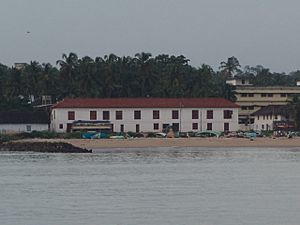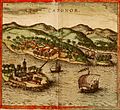Arakkal kingdom facts for kids
Quick facts for kids
Arakkal Kingdom
അറക്കൽ രാജവംശം (Malayalam)
|
|||||||||
|---|---|---|---|---|---|---|---|---|---|
| 1545–1819 | |||||||||
| Capital | Cannanore (now Kannur) | ||||||||
| Common languages | Malayalam | ||||||||
| Religion | Islam | ||||||||
| Government | Monarchy | ||||||||
| History | |||||||||
|
• Established
|
1545 | ||||||||
|
• Annexed to British India
|
1819 | ||||||||
|
|||||||||
The Arakkal Kingdom was a unique Muslim kingdom located in Kannur town, in the state of Kerala, South India. Unlike most kingdoms, it was sometimes ruled by a king, called Ali Raja, and sometimes by a queen, known as Arakkal Beevi.
This kingdom was special because its rulers followed a system called Marumakkathayam. This meant that the oldest member of the family, whether male or female, became the next ruler. This system of inheritance is rare and was unique to some Hindu families in Kerala. The Arakkal family was the only Muslim royal family in the region to follow it.
The Arakkal Kingdom mainly controlled the town of Kannur and some of the southern Laccadive Islands, including Agatti, Kavaratti, Androth, Kalpeni, and Minicoy. These islands were originally rented from another local ruler called the Kolattiri. The Arakkal royal family is believed to have started from a princess of the Kolattiri family who became a Muslim.
Over time, the Arakkal rulers became very powerful, especially as they controlled important trade routes. They often allied with or fought against other powers, including the Kingdom of Mysore and later European forces like the British.
Contents
Arakkal Kingdom: A Unique History
The Arakkal Kingdom was a significant power in Kannur for many years. Its palace, which the rulers bought from the Dutch in 1663, is now known as the Arakkal Museum.
How the Arakkal Kingdom Began
There are a few stories about how the Arakkal Kingdom started. One popular legend says that the last ruler of the Chera Empire, Rama Varma Kulashekhara Perumal, became a Muslim after meeting an Islamic missionary named Malik Deenar. Perumal's nephew, Mabeli, also converted to Islam and took the name Muhammad Ali. He is believed to have become the first Arakkal Ali Raja.
Another story tells of a princess from the Chirakkal royal family who was drowning in a pond. A man named Muhammad Ali rescued her. According to the customs of that time, if a man gave a cloth to an unmarried woman to cover herself, they were considered married. Since Muhammad Ali had rescued the princess and given her his cloth, the Chirakkal Raja had to agree to their marriage. The area given to Muhammad Ali and his family was named Arakkal, and that's how the Arakkal family began.
The Arakkal rulers were very strong, especially when they allied with the Kingdom of Mysore. This strength allowed them to stand up to European powers like the British. For example, they stopped the British East India Company from building a military base in Dharmadam, which was an important area for the Arakkal Kingdom.
Where is the Arakkal Palace?
The Arakkal palace is located about three kilometers from Kannur town in Kerala, India. It stands as a reminder of Kerala's only Muslim royal family.
Rulers: Ali Rajas and Arakkal Beevis
The Arakkal family had a special way of choosing their rulers. They followed a matriarchal system, meaning the oldest member of the family, whether male or female, would become the next leader.
- Male rulers were known as Ali Raja.
- Female rulers were known as Arakkal Beevi.
For example, Sultana Aysha Aliraja was the ruler until 2006. More recently, Adiraja Mariyumma, also known as Cheriya Bikkunhu Beevi, became the head of the Arakkal family in 2019.
Arakkal's Place in History
Trade between the Middle East and the Malabar Coast (where Kerala is) was happening long before the time of Prophet Muhammad. Islam came to Kerala through these traders. Some historians believe Islam arrived as early as the seventh century CE.
The Arakkal rulers played an important role in the history of Malabar. They had strong trade connections and even had their own navy. They also formed alliances and sometimes clashed with European powers like the Portuguese, the Dutch, the French, and the British. The British eventually played a big part in reducing the power of the Arakkal rulers.
By 1909, the Arakkal rulers had lost control of Kannur. By 1911, they had lost their symbols of power, like their royal sceptre and sword. Despite this, some later rulers, like Abdu Rahiman Ali Raja, worked hard to help their people. The last official ruler was Ali Raja Mariumma Beevi Thangal. After her rule, the family's formal power ended.
Arakkal's Foreign Relationships
The Arakkal rulers were not just local leaders; they also had connections with powerful empires far away. In 1777, Ali Raja Kunhi Amsa II, who was an ally of Hyder Ali of the Kingdom of Mysore, sent a letter to the Ottoman Empire. He asked for help against the British East India Company. Two years later, his sister, Ali Raja Bibi Junumabe II, also asked for urgent help against the Portuguese and British during a war.
Arakkal Museum
The Durbar Hall (the royal court area) of the Arakkalkettu (Arakkal Palace) has been turned into a museum. It displays many items from the time of the Arakkal dynasty. The Government of Kerala helped restore the palace, and the museum opened in July 2005.
The Arakkalkettu is owned by the Arakkal Trust, which includes members of the royal family. The government wanted to protect the history of the Arakkal Family because they were so important in the history of Northern Kerala. Visitors can pay a small fee to enter the museum and learn about this unique kingdom.
List of Arakkal Rulers
Here are some of the important Ali Rajas and Arakkal Beevis who ruled the kingdom:
- Ali Raja Ali (1545–1591)
- Ali Raja Abubakar I (1591–1607)
- Ali Raja Abubakar II (1607–1610)
- Ali Raja Muhammad Ali I (1610–1647)
- Ali Raja Muhammad Ali II (1647–1655)
- Ali Raja Kamal (1655–1656)
- Ali Raja Muhammad Ali III (1656–1691)
- Ali Raja Ali II (1691–1704)
- Ali Raja Kunhi Amsa I (1704–1720)
- Ali Raja Muhammad Ali IV (1720–1728)
- Ali Raja Bibi Harrabichi Kadavube (1728–1732)
- Ali Raja Bibi Junumabe I (1732–1745)
- Ali Raja Kunhi Amsa II (1745–1777)
- Ali Raja Bibi Junumabe II (1777–1819)
Images for kids
See also
 In Spanish: Reino de Arakkal para niños
In Spanish: Reino de Arakkal para niños










